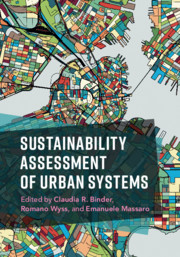Book contents
- Sustainability Assessment of Urban Systems
- Sustainability Assessment of Urban Systems
- Copyright page
- Contents
- Preface
- Acknowledgments
- Contributors
- General Introduction
- Part I Theoretical Background
- Part II Integrative Approaches for Sustainability Assessment
- 6 A Mixed-Method, Dialogue-Based Approach to Sustainability Assessments: Fostering Learning for Sustainable Development
- 7 Sustainability Assessment: Integrative Concept, Methodology, and Examples
- 8 Sustainability Solution Spaces
- 9 Assessing Urban Sustainability through Participatory Multi-Criteria Approaches (PMCAs): An Updated Comparative Analysis
- Part III Perspectives on Urban Sustainability
- Part IV Focal Points of Urban Sustainability
- Index
- References
7 - Sustainability Assessment: Integrative Concept, Methodology, and Examples
from Part II - Integrative Approaches for Sustainability Assessment
Published online by Cambridge University Press: 27 March 2020
- Sustainability Assessment of Urban Systems
- Sustainability Assessment of Urban Systems
- Copyright page
- Contents
- Preface
- Acknowledgments
- Contributors
- General Introduction
- Part I Theoretical Background
- Part II Integrative Approaches for Sustainability Assessment
- 6 A Mixed-Method, Dialogue-Based Approach to Sustainability Assessments: Fostering Learning for Sustainable Development
- 7 Sustainability Assessment: Integrative Concept, Methodology, and Examples
- 8 Sustainability Solution Spaces
- 9 Assessing Urban Sustainability through Participatory Multi-Criteria Approaches (PMCAs): An Updated Comparative Analysis
- Part III Perspectives on Urban Sustainability
- Part IV Focal Points of Urban Sustainability
- Index
- References
Summary
The Integrative Concept of Sustainable Development (ICoS) was developed through an intensive process in order to operationalise the guiding rules of sustainable development in an interdisciplinary team. Through its three general sustainability goals and 25 sustainability rules, ICoS establishes that indicators are part of a step-wise, systematic, and consistent construction that links theoretical abstraction to deliberative action: the political and societal practice of sustainable development (Barton & Kopfmüller, 2012, p. 84). The application of the concept is presented through two examples: a completed project in Santiago de Chile, and a project currently being developed, which will enable the calculation of regional sustainable energy balances.
Keywords
- Type
- Chapter
- Information
- Sustainability Assessment of Urban Systems , pp. 161 - 180Publisher: Cambridge University PressPrint publication year: 2020



